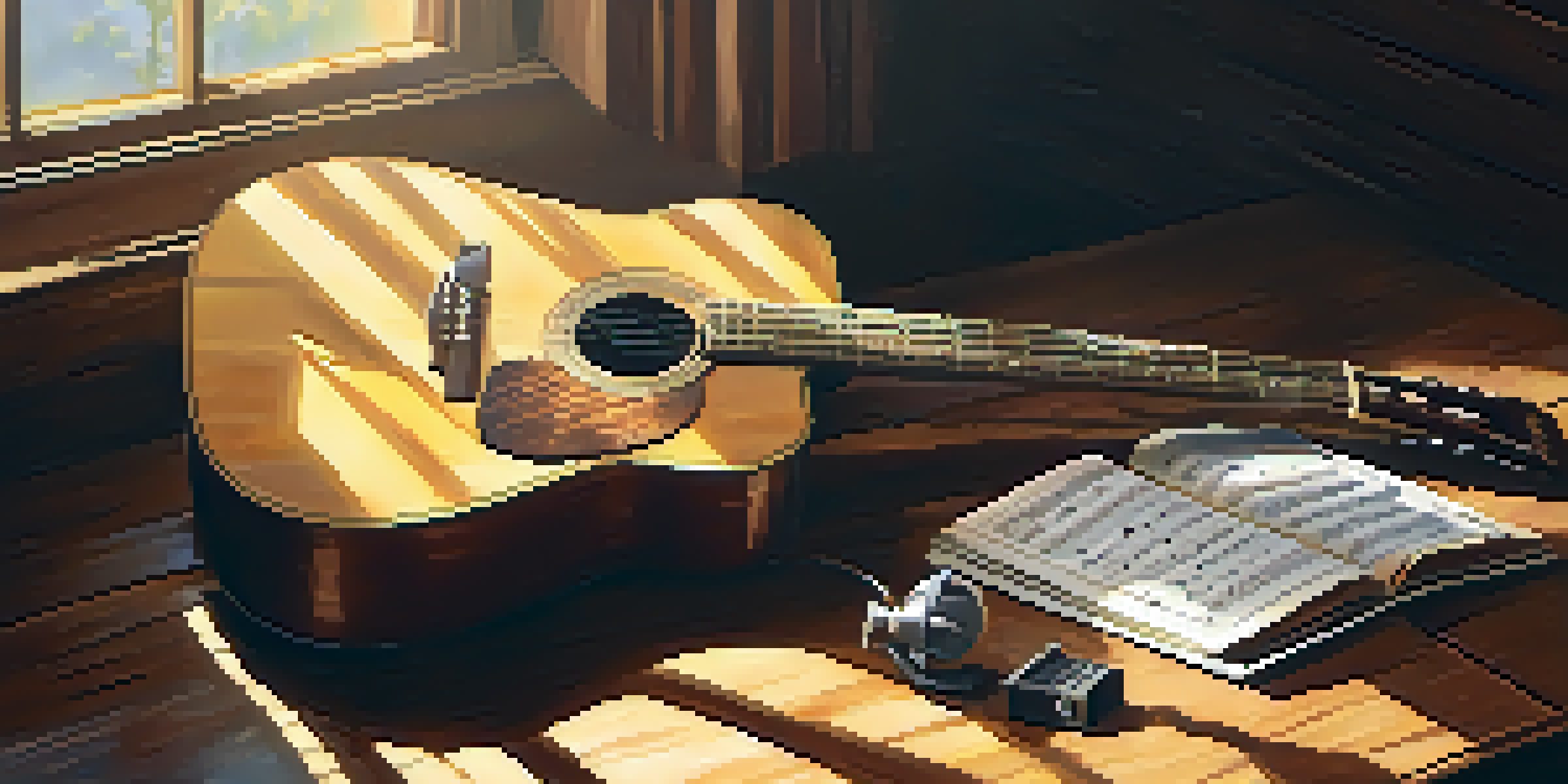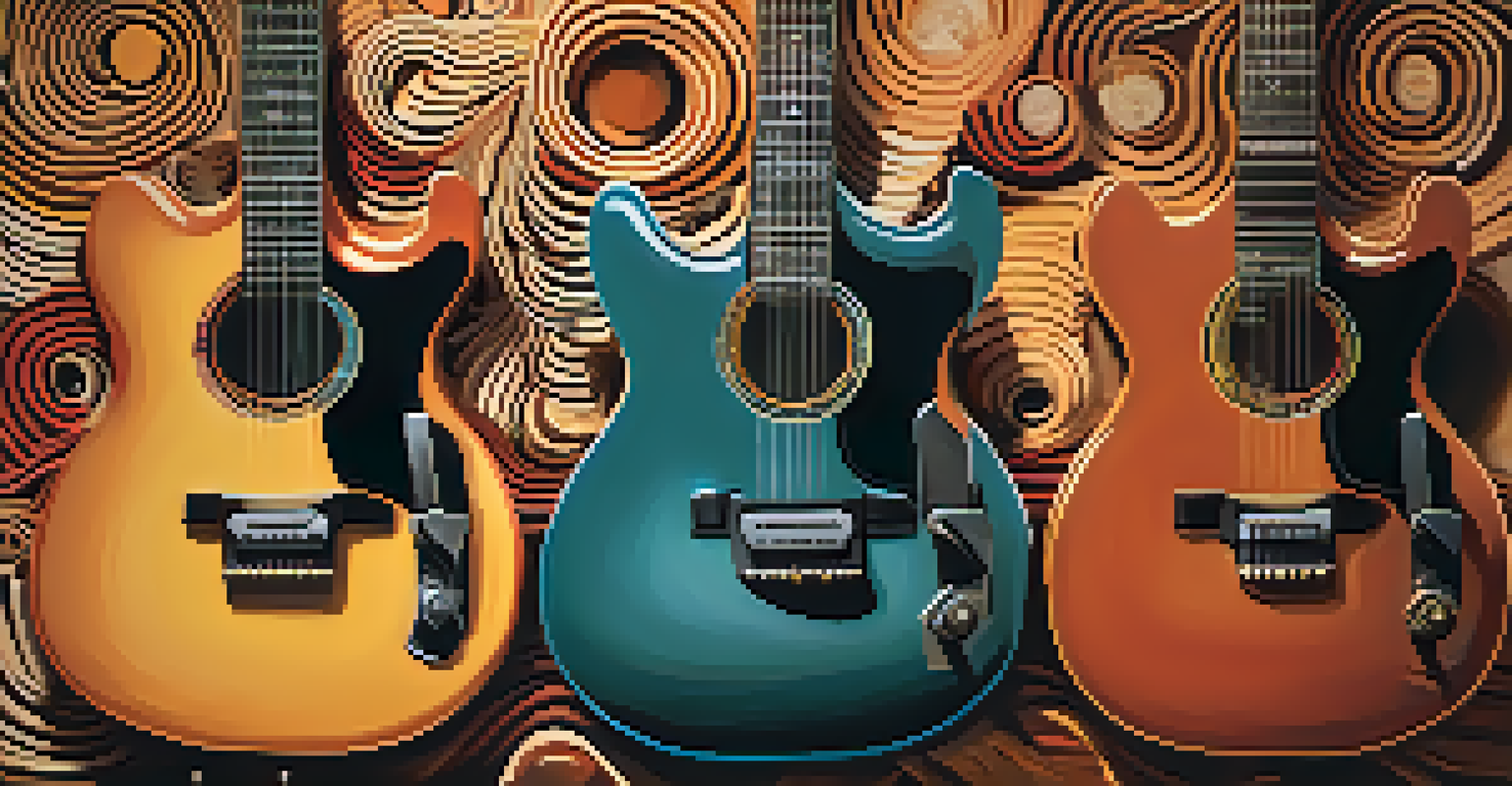Songwriting Approaches: Acoustic vs. Electric Music Styles

Understanding Acoustic Music: A Timeless Approach
Acoustic music, often characterized by its organic sound, relies on traditional instruments like guitars, pianos, and violins. This style emphasizes the rawness of sound, allowing songwriters to connect deeply with their audience through simplicity and authenticity. Many iconic songs have emerged from acoustic settings, showcasing how powerful a single instrument and voice can be.
Music is the shorthand of emotion.
When writing acoustic songs, the focus often shifts to lyrical content and melody. The stripped-back nature encourages songwriters to be more introspective, crafting lyrics that resonate on a personal level. Think of artists like Ed Sheeran or Taylor Swift, who often draw from their own experiences to create relatable narratives that listeners can embrace.
Moreover, acoustic songwriting can be incredibly versatile. Whether it’s a soft ballad or a lively folk tune, the essence of acoustic music allows for various styles to emerge. This adaptability can inspire songwriters to explore different emotions and themes, ultimately leading to a more profound connection with their craft.
Electric Music: Embracing Innovation and Energy
Electric music, on the other hand, introduces a plethora of new sounds and possibilities through technology and amplification. Instruments like electric guitars, synthesizers, and drum machines create a dynamic atmosphere that can elevate a song's energy. This style often appeals to those looking to experiment and push the boundaries of traditional songwriting.

In the realm of electric music, songwriters can layer sounds, creating rich tapestries of audio that enhance the listening experience. The use of effects such as reverb, distortion, and loops can transform a simple idea into a full-fledged production. Artists like Daft Punk and Billie Eilish exemplify this approach, blending different genres and sounds to create something entirely unique.
Acoustic Music: Raw and Relatable
Acoustic music emphasizes simplicity and authenticity, allowing artists to connect with listeners through heartfelt lyrics and melodies.
Electric songwriting also opens up opportunities for collaboration. With technology at their fingertips, songwriters can easily work together from different locations, sharing ideas and sounds in real-time. This collaborative spirit often leads to innovative compositions that might not have been possible in a more traditional acoustic setting.
Song Structure: Differences Between Acoustic and Electric
When it comes to song structure, acoustic and electric styles often take different paths. Acoustic songs frequently follow traditional formats like verse-chorus-verse, allowing the lyrics to shine through in a straightforward manner. This structure not only highlights the storytelling aspect but also creates a familiar rhythm that audiences can easily latch onto.
The beautiful thing about music is that it transcends language.
On the flip side, electric music often encourages more experimentation with song structure. Artists may opt for unconventional forms, using breaks, drops, or extended instrumental sections to surprise listeners. This flexibility can lead to innovative transitions that keep the audience engaged and eager for what’s next.
Ultimately, the choice of structure can reflect the songwriter's vision, whether they aim for simplicity and clarity or complexity and surprise. Understanding these differences can help aspiring songwriters choose the best approach for their intended message and emotional impact.
Lyrical Themes: Acoustic Intimacy vs. Electric Ambiance
Lyrical themes in acoustic music often delve into personal experiences, emotions, and storytelling. The intimate nature of acoustic songwriting allows artists to explore their vulnerabilities, creating a heartfelt connection with listeners. Songs like 'Fast Car' by Tracy Chapman exemplify how a simple acoustic arrangement can convey deep, relatable narratives.
In contrast, electric music frequently embraces broader themes and abstract concepts. The enhanced soundscapes enable artists to experiment with ideas that may not translate as effectively in an acoustic format. For example, electronic tracks often explore futuristic themes, societal issues, or even fantastical narratives that invite listeners to escape into another world.
Electric Music: Innovation and Energy
Electric music leverages technology and diverse instrumentation to create dynamic soundscapes, encouraging experimentation and collaboration among artists.
This distinction in lyrical themes showcases how the choice of instrumentation can shape a song's message. By understanding these varying approaches, songwriters can better determine how to express their ideas, whether through the warmth of acoustic melodies or the expansive possibilities of electric sound.
Instrumentation Choices: Crafting the Right Sound
The choice of instrumentation plays a crucial role in defining the sound and mood of a song. In acoustic music, instruments like acoustic guitars, violins, and hand drums create a warm, earthy feel that often evokes nostalgia and comfort. This choice encourages a direct connection between the artist and the listener, enhancing the emotional weight of the lyrics.
In electric music, the range of instruments expands dramatically, introducing synthesizers, electric guitars, and digital samples. This diversity allows for a wider spectrum of sound, enabling artists to create complex layers that can evoke a variety of emotions. Think of how artists like The Weeknd use electric instrumentation to create atmospheric soundscapes that draw listeners into a different realm.
Ultimately, the decision regarding instrumentation will influence not only the sound but also the overall message of the song. By thoughtfully selecting instruments, songwriters can align their sonic choices with the emotions they wish to convey, whether through the authenticity of acoustic sounds or the boldness of electric music.
Performance Styles: Acoustic vs. Electric Showcases
The way a song is performed can significantly impact its reception, and this is particularly true for acoustic versus electric styles. Acoustic performances often feel more personal and intimate, drawing audiences in with the simplicity of the setup. Artists like Bon Iver often perform in stripped-down settings, allowing their vulnerability and connection to shine through.
Electric performances, however, tend to be more dynamic and visually stimulating. The use of lights, effects, and a full band can create an electrifying atmosphere that captivates audiences. Bands like Coldplay use vibrant visuals and energetic performances to enhance their electric songs, making the live experience unforgettable.
Fusing Styles for Unique Sound
Blending acoustic and electric elements enables artists to explore emotional depth while pushing genre boundaries, resulting in innovative and engaging compositions.
These performance styles highlight the different ways artists engage with their audiences. Whether it’s the heartfelt storytelling of an acoustic set or the high-energy spectacle of an electric performance, both approaches offer unique and powerful experiences.
Combining Styles: The Best of Both Worlds
In the ever-evolving landscape of music, many artists find value in blending acoustic and electric styles. This fusion allows songwriters to tap into the emotional depth of acoustic music while leveraging the innovative energy of electric sound. For instance, artists like Hozier often incorporate both styles in their music, creating rich, layered compositions that appeal to a wide audience.
Combining these approaches can also lead to unique sounds that challenge traditional genre boundaries. Genres like folk-rock and indie pop often showcase this fusion, allowing artists to experiment with various elements from each style. This adaptability can result in fresh, exciting songs that resonate with diverse groups of listeners.

Ultimately, the beauty of music lies in its versatility. By exploring both acoustic and electric songwriting approaches, artists can discover new ways to express their creativity, resulting in innovative and engaging music that transcends conventional categories.